NORTH WALES COAST RAILWAY:NOTICE
BOARD
Rheilffordd arfordir gogledd Cymru: Hysbysfwrdd
06 January 2014
 Last issue
Last issue Archive
Archive Share this issue
Tweet
Tweets by @NWrail1
Contributions and comments are encouraged: see the Contributions Page
This site is dedicated to all our regular contributors and supporters, and especially the rail staff of North Wales.
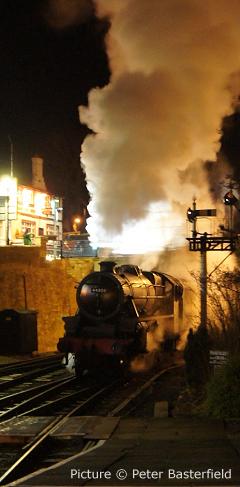
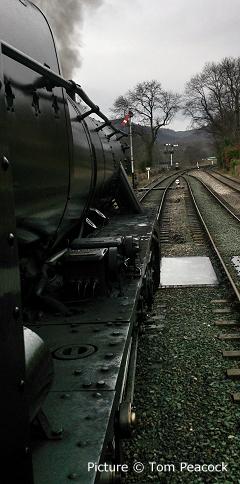
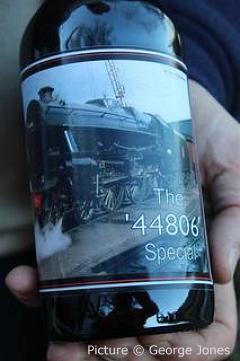
This list may be out of date if you are reading an archived page. For the current list visit our Calendar.
January 2014
Tuesday 7 January North Wales Railway Circle Bob Barnsdale of the Llandudno & Conwy Valley Rly Society; gives an evening on LNWR Motive Power Depots.
Thursday 9 January Llandudno and Conwy Valley Railway Society 'From a Driver’s point of view' Dave Trains
Friday 10 January Altrincham Electric Preservation Society HISTORY OF BOLTON TRAMWAYS by Derek Shepherd (Vice-Chairman, Heaton Park Tramway)
Monday 13 January Wrexham Railway Society. ANNUAL GENERAL MEETING AND RAIL REVIEW ENTERTAINMENT Annual General Meeting will be followed by various members’ own presentations.
Monday 20 January RCTS Merseyside, Chester & North Wales BRANCH A.G.M Followed by Alan Donaldson ‘Around Britain 1983 to 2010’
Thursday 30 January Merseyside Railway History Group David Rapson 'Seacombe to Wrexham'
Friday 31 January Great Western Society North West Branch The Cowley Hill Colliery to the Runcorn Gap Railway.
Friday 28 February Great Western Society North West Branch Group Annual Meeting followed by Members Slides.
February 2014
Tuesday 4 February North Wales Railway Circle Bill Rogerson returns with 'Rails around UK.'
Friday 7 February Clwyd Railway Circle Brian Bollington & Peter Hanahoe 'Polish Steam' The presentation is a mix of slide shows and video showing steam on the national network, including shed scenes, taken in the 1990’s.
Monday 10 February Wrexham Railway Society. Fred Kirk, A Scottish Trip 60 Years On. The results of a week long trip to Scotland, shed bashing previously not seen, black and white images of long gone shed scenes, Princes Street station etc.
Thursday 13 February Llandudno and Conwy Valley Railway Society 'A short history of Crosville & my time with it' Clive Myers
Friday 14 February Altrincham Electric Preservation Society (Change of programme) Well-known railway photographer Peter Fitton from the Fylde will be giving a slide show entitled "The Railways of the Fylde from 1961".
Monday 17 February RCTS Merseyside, Chester & North Wales Barry Shore ‘BR freight in the post steam era 1967 to 1979’
Thursday 20 February Locomotive Club of Great Britain John Sloane "BR Scenes from the 60s”
Thursday 27 February Merseyside Railway History Group Allan Lewis 'Union Pacific Steam'
March 2014
Tuesday 4 March North Wales Railway Circle Ken Robinson shows 'Chester to Holyhead including Llandudno branch' slides.
Friday 7 March Clwyd Railway Circle The Committee & David Southern AGM followed by the talk 'Railways of the Wirral' After the formality is over, we can look forward to Dave sharing his railway experiences of 60 years living on the Wirral.
Monday 10 March Wrexham Railway Society. Geoff Morris- Railways of New Zealand a digital presentation based on two steam-hauled trips around New Zealand in 2011 & 2012 including both preservation activities and the rapidly-changing current railway scene on the other side of the world.
Thursday 13 March Llandudno and Conwy Valley Railway Society 'The Dinorwic Quarry Railway & its locomotives' Eric Lander
Monday 17 March RCTS Merseyside, Chester & North Wales ‘The Ugly Duckling’: Bob Casselden looks at the transformation of B.R.’s ‘Other Provincial Services’ via ‘Regional Railways’ into today’s privatised railways
Friday 14 March Altrincham Electric Preservation Society A Selection of Doug Darby's UK PHOTOGRAPHS by Paul Shackcloth (Photographic Officer, Manchester Locomotive Society)
Thursday 23 January Locomotive Club of Great Britain Neville Bond “From Sea to Shining Sea” 30 years of North American scenes
Thursday 20 March Locomotive Club of Great Britain Dr Michael Bailey "The Manchester Ship Canal Railway"
Thursday 27 March Merseyside Railway History Group AGM & Members Slides
April 2014
Friday 4 April Clwyd Railway Circle Ron Watson-Jones 'The Irish Mail Train Crash at Penmaenmawr Aug 1950' Ron’s account of the accident on 27th August 1950.
Tuesday 4 April North Wales Railway Circle Dave Rapson of Connah`s Quay presents a pictorial record of The Bidston - Wrexham Line.
Thursday 10 April Llandudno and Conwy Valley Railway Society 'Welsh Wanderings in the 1980’s & 90’s' Geoff Morris
Thursday 10 April Merseyside Railway History Group Ted Lloyd 'Quiz and informal evening'
Friday 11 April Altrincham Electric Preservation Society Slides from the Manchester locomotive society collection by David Young. Mainly steam locomotives taken 1950s and 1960s
Monday 14 April Wrexham Railway Society. Jon Penn. Railway Pictures From the 1960’s –scanned black and white negatives and vintage colour slides, favouring the Cheshire and surrounding areas.
Monday 28 April RCTS Merseyside, Chester & North Wales ‘South of the Border steam in the 50s and 60s’ by David Kelso, David travels from Kent to present a follow up to his earlier North of the border presentation, including a period when he was resident in the West Riding of Yorkshire.
Thursday 17 April Locomotive Club of Great Britain Norman Matthews "Steam in Central America"
May 2014
Tuesday 6 May North Wales Railway Circle A.G.M. followed by Members Videos, Prints, Slides, and Digital work in the Photo Competition.
Thursday 8 May Llandudno and Conwy Valley Railway Society 'The Deganwy Dock Story' Eric Smith
Thursday 15 May Locomotive Club of Great Britain AGM and Members/Visitors Slides & Digital Photos.
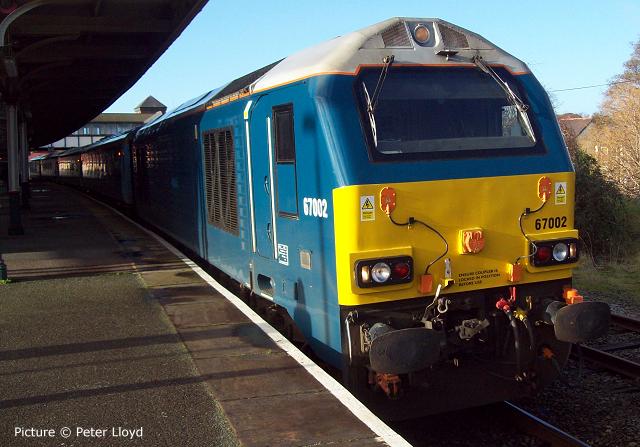
Reduced to three carriages and driving van trailer, after two carriages were damaged in an incident involving some corrugated sheet blown on to the track, on 27 December (see last issue), the 12:17 Holyhead - Crewe 'holiday extra' on 31 December calls at sunny Llandudno Junction. Picture by Peter Lloyd.
Thanks to everyone who has sent Christmas and New Year wishes and kind comments. Much appreciated.- Charlie
More storm and flood problems
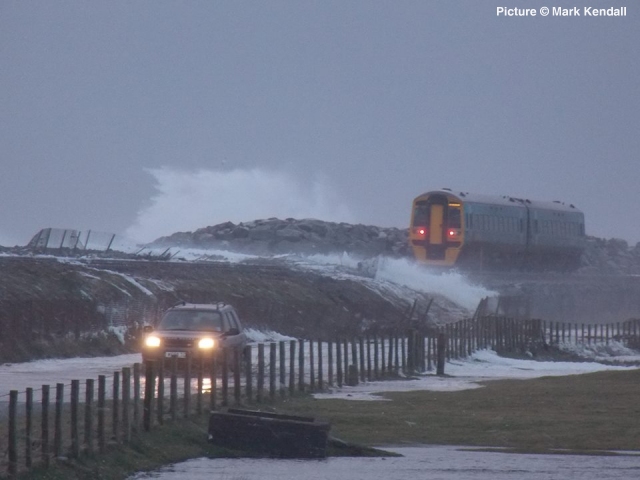
Friday 3 January saw severe weather problems affecting all the lines in our area. Floods combined with very high tides caused damage to the Conwy Valley and Cambrian Coast Lines, leading to complete closure between Llandudno Junction and Blaenau Ffestiniog and between Machynlleth and Pwllheli. Llanelli to Carmarthen in South Wales was also blocked.
The Cambrian Coast line, which is already out of use north of Harlech due to the non-weather-related damage to the Briwet Bridge, has been rendered unusable in a number of places. The picture above, by Mark Kendall, shows the state of the shore-line section between Tonfanau and Tywyn with the 07:17 Harlech to Machynlleth train stopped short as waves break over the line on to the adjacent road.
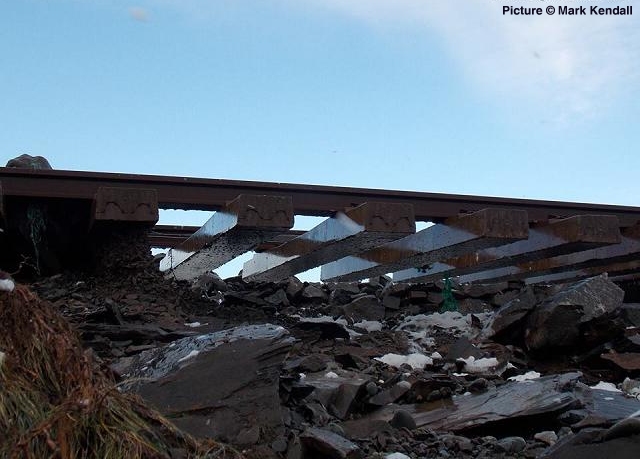
A close-up of the wash-out between the rails. Picture By Mark Kendall.
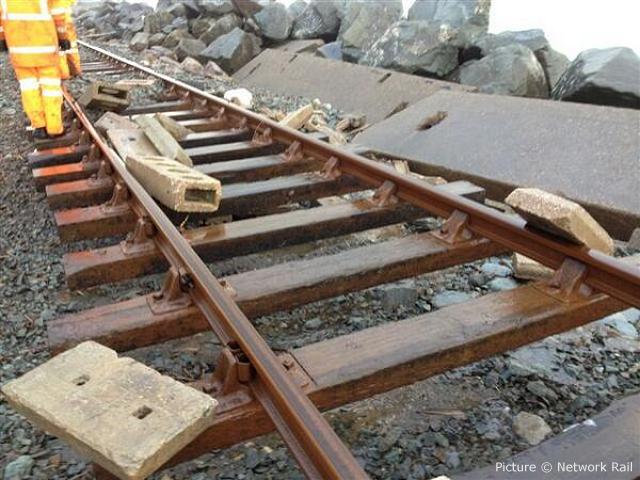
The 06:47 Machynlleth - Harlech has passed through the area, but was terminated at Barmouth due to problems on the sea wall at Llanaber, seen above in Network Rail's picture. The coast protection here is provided by large boulders, augmented by miscellaneous large masonry blocks brought from redundant structures elsewhere.
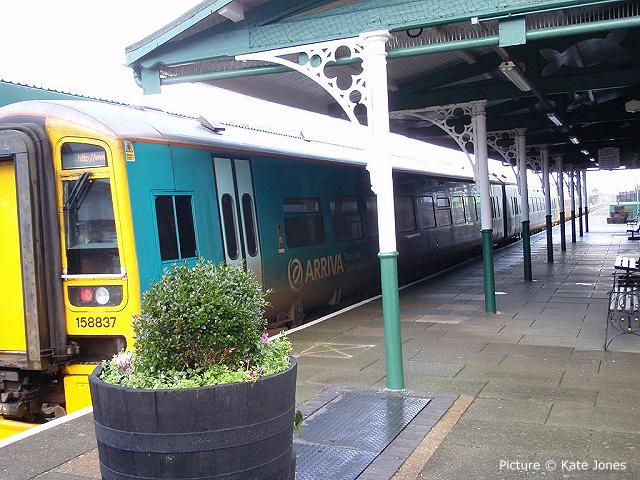
At Barmouth, the unit from Harlech, was coupled to the one which had returned from Tonfanau. Our picture by Kate Jones shows 158 837 and 158 831 at Barmouth. about to be moved to the siding.
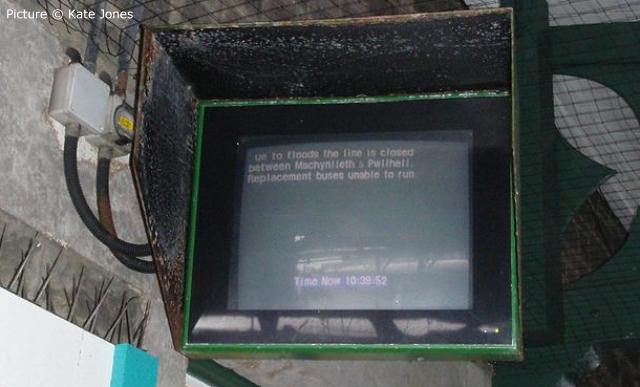
As the screen at Barmouth states, no bus replacements could operate either. Kate Jones relates: 'Even with my Land Rover Discovery I had to wait two hours before travelling north to get back to Dolgellau via Trawsfynydd due to road flooding at Llanbedr.'
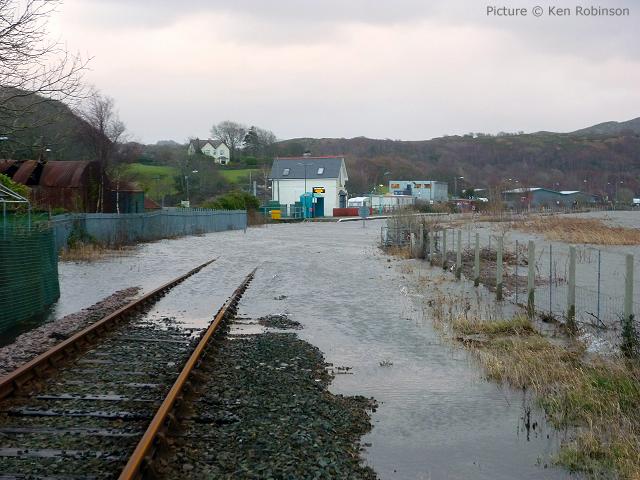
On the section already out of use, Ken Robinson photographed the scene at Penrhyndeudraeth station, seen from the nearby level crossing at high tide at 09:45 on 3 January. The information display is still displaying its 'no trains message' as the water almost reaches platform level. A combination of strong South West winds and high tides makes this location very vulnerable. As of 6 January a bus replacement service of has been organised: PDF timetable here. All-stops buses are connecting at Barmouth with a Machynlleth - Pwllheli express bus which calls only at Tywyn, Barmouth, Harlech and Porthmadog.
As we write this on Monday 6 January, Machynlleth to Aberystwyth has also been closed. See also the Daily Post which has a picture sequence.
On the North Wales Coast line, all train movements west of Chester trains were suspended as a precaution during the high tide period in the middle of the day on 3 January, but resumed in the afternoon, although part of the town of Rhyl was flooded.
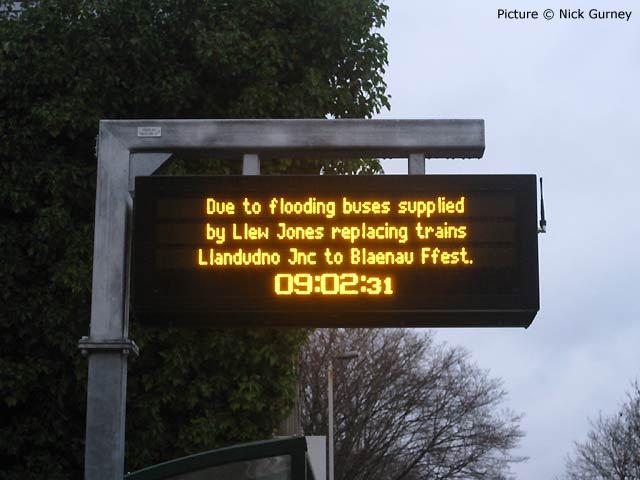
On the Conwy Valley, Nick Gurney photographed a message at North Llanrwst complete with operator information.
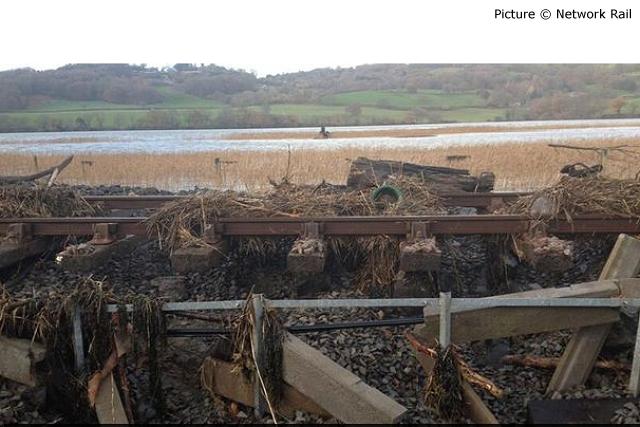
Here's a view of some track near Llanrwst. The line will be closed until 12 January at the earliest, according to Network Rail.
News of new locomotives
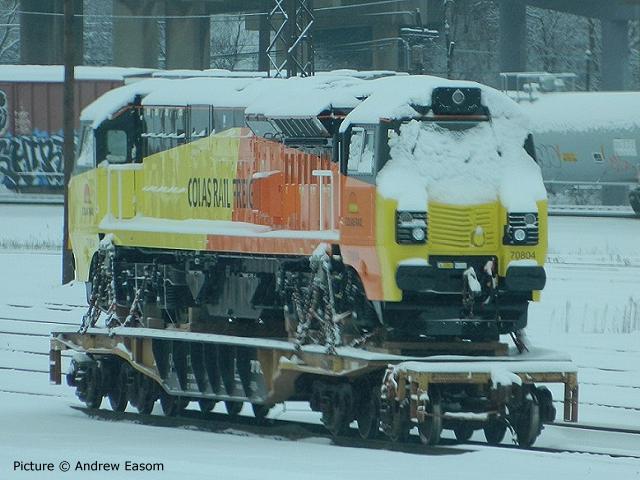
Delivery has begun of nine 'class 70' locomotives ordered by Colas Rail from General Electric in the USA. These are the same type as the Freightliner Class 70s, and will join the Turkish-built example 70 801 in the Colas fleet. Andrew Easom, a reader living in the US, sends these two fine views of 70 804 sitting on a special heavy-load flatcar (note the four bogies) in Norfolk Southern's Rockport Yard near Cleveland, Ohio on 1 January, on its way from the GE plant in Erie, Pennsylvania waiting to be taken to Norfolk, Virginia for export.
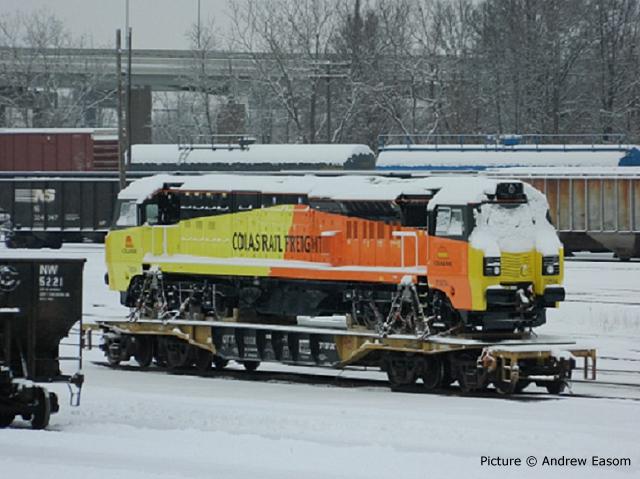
The weather in northern Ohio has been rather cold recently: on 5 January the temperature in Cleveland is minus 16 degrees C, and weather websites are suggesting wind chill factors down to 'extremely dangerous' minus 40 later in the week.
Meanwhile back in windy England, Two other locos, 70 803 and 70 805, were landed from the Atllantic Concert during the night of 5/6 January at Seaforth Docks, Liverpool. A picture published on Twitter (scroll down our Twitter feed in the left column) shows them on roll-on roll-off trailers, which should avoid the risk of one dropping from a crane, as happened to Freightliner machine 70 012.
The first example for of a completely new class of diesel ordered by DRS, 68 002, to arrive in the UK in the near future, having been completed by the Vossloh works in Spain. It too may come by sea, as the first-built loco, 68 001, now undergoing tests at the Velim test track in the Czech Republic, travelled from Spain to the port of Lübeck aboard the MV Lyrika, reaching the Baltic Sea via the Kiel Canal and thence by rail to Velim. Spanish railways are a different track gauge to the UK, which may be the reason for this.
Llangollen Railway events (1): Winter Warmer
The Llangollen Railway's 'Winter Warmer' event of 4-5 January featured a good selection of the railway's motive power. Notable were the last runs on this line by 'Black 5' 44806 which has been sold by its owner and will in future be running on the North Yorkshire Moors Railway. Above, 44806 blasts under the road bridge at Berwyn with the 10:00 Llangollen - Carrog (Bob Greenhalgh).
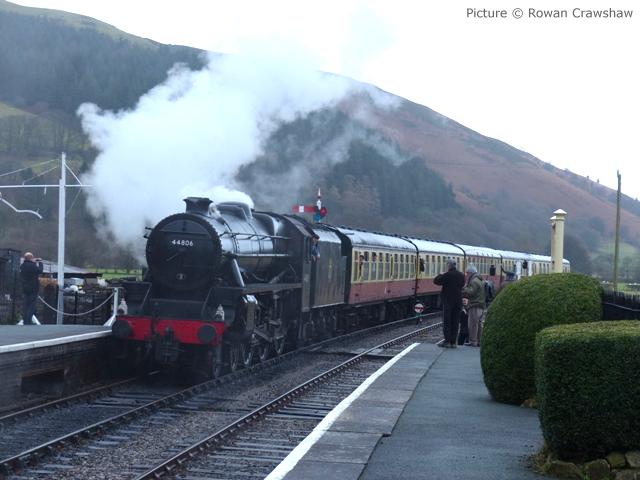
44806 arrives at Carrog with the 10:00 from Llangollen on 4 January 2014 (Rowan Crawshaw). This loco has a long history in preservation, having been bought by the late Kenneth Aldcroft and moved to 'Steamtown' at Carnforth at the end of British Rail main line steam in August 1968. It has not always been in working order, however. After working for a few years, a fault was discovered, and it spent time as a static exhibit, first at Steamport, Southport and when that closed, at the Museum of Science and Industry. In 1993 it was finally moved to Llangollen for repairs, and entered service there in 1995 and has been based there ever since, including another overhaul, completed in 2007.
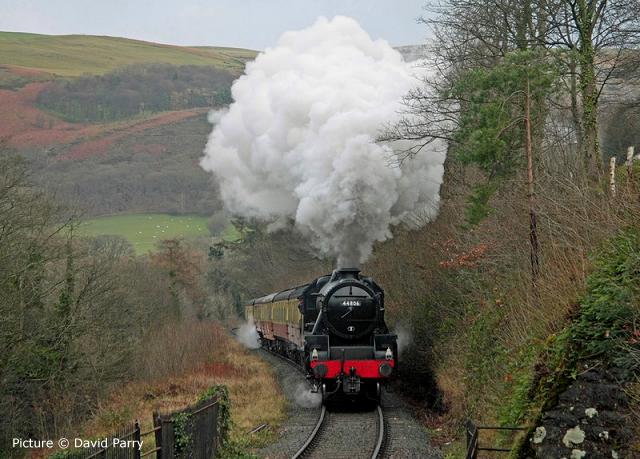
44806 makes a spirited approach to Berwyn on the 1240 Llangollen – Carrog on Saturday 4 January (David Parry). For a more detailed history of the loco, see the Llangollen Railway website.
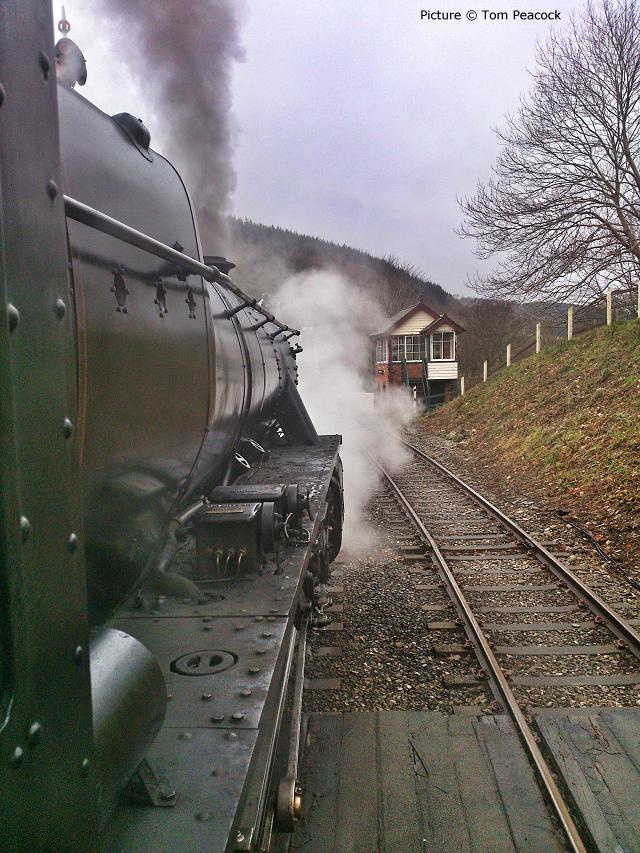
The view from the footplate, as seen by Tom Peacock at Glyndyfrdwy on 4 January. The boxes with pipes emerging from them are mechanical lubricators, which ensure a supply of oil to the moving parts of the loco. One supplies the valved and cylinders, the other the wheel bearings. This type was standard on LMS and BR standard locomotives.
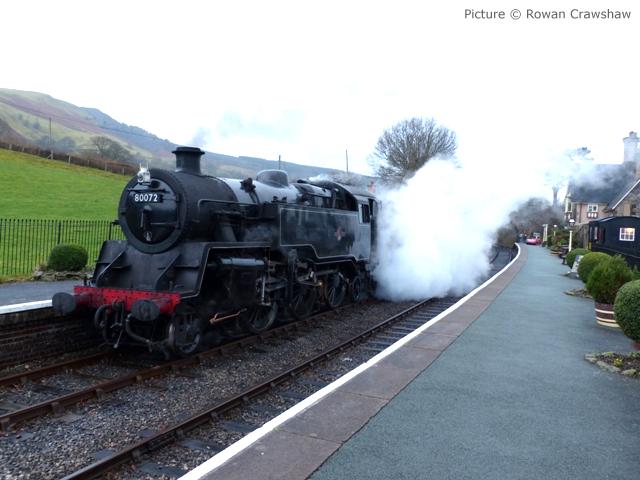
Above, BR Standard 2-6-4T 80072 awaits departure with the 10:25 to Llangollen at Carrog on 4 January (Rowan Crawshaw).
80072 on the same train approaching milepost 7¼ near Berwyn (Bob Greenhalgh).
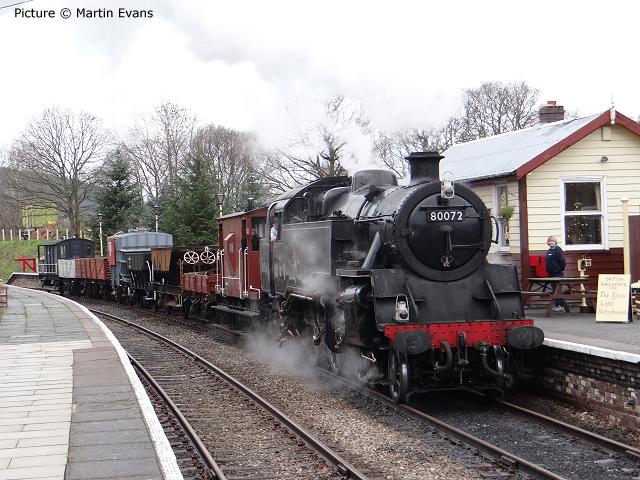
80072 glides through Glyndyfrdwy with the 13 17pm freight from Carrog to Llangollen Goods Junction (Martin Evans).
The 09:06 Bonwm - Llangollen at Berwyn, formed of the hybrid diesel multiple unit comprising Class 127 motor car 51618 and Class 108 trailer 56223 (Bob Greenhalgh).
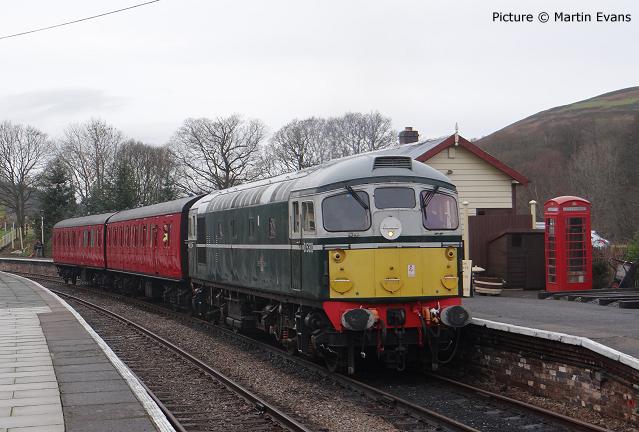
Class 26 diesel D5310 prepares to leave Glyndyfrdwy with the 12:39 service from Bonwm, formed of the line's two 'suburban' non-corridor coaches (Martin Evans).
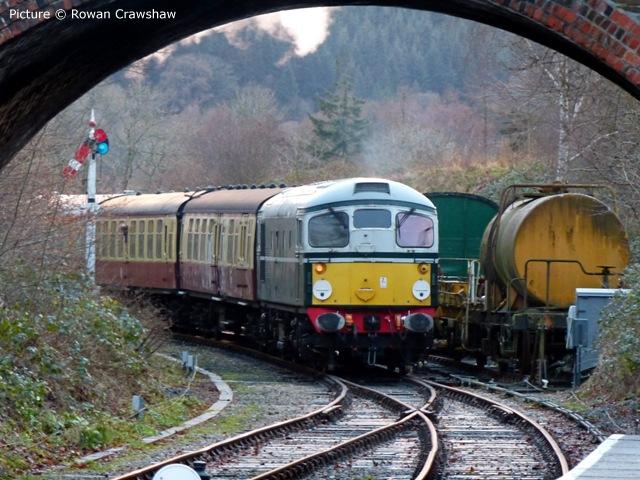
D5310 at Carrog on its way to Bonwm with the 15:00 from Llangollen on 4 January 2014 (Rowan Crawshaw).
D5310 near Berwyn on 4 January with a demonstration freight, including the line's preserved 'Presflo' wagon in Tunnel Cement livery: these once ran to Bangor goods yard (Bob Greenhalgh).
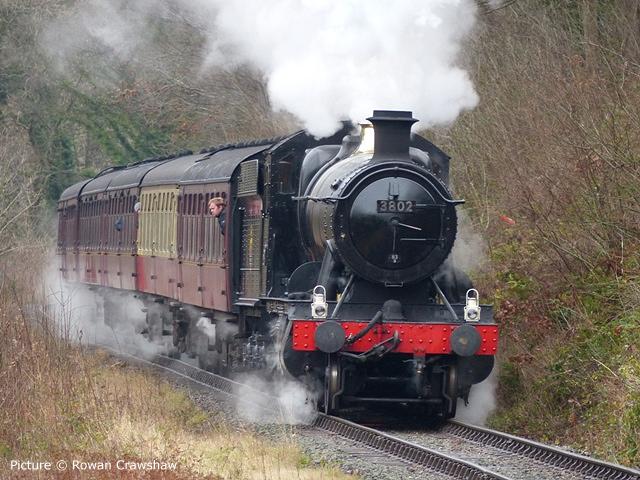
GWR 2800 Class No 3802 arrives at Berwyn with the 11:00 from Llangollen on 4 January (Rowan Crawshaw).
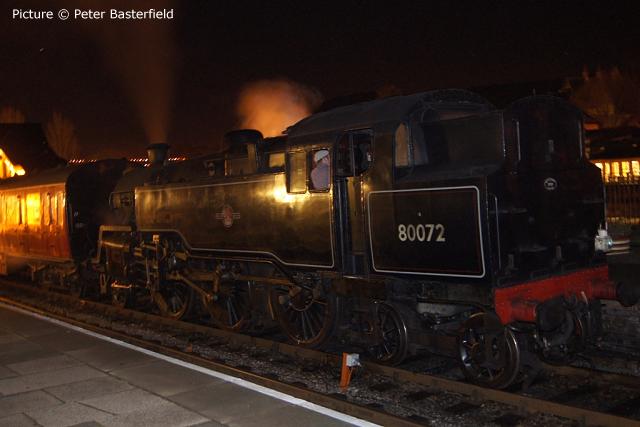
Peter Basterfield visited Llangollen in the evening of 4 January to take these dramatic pictures for us. Above, 80072 ...
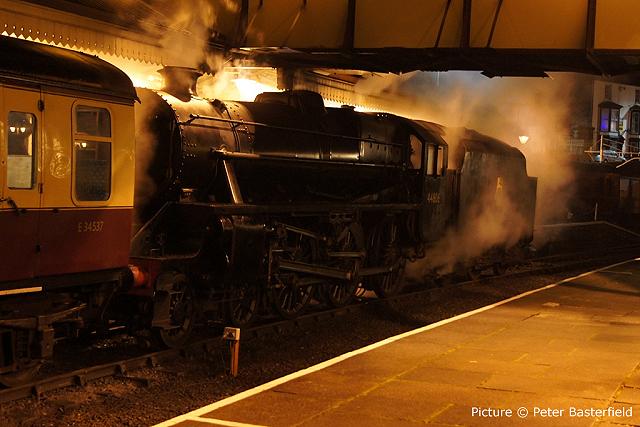
... and 44806. A special 'New Year Cheer' train ran in the evening. Special beer was bottled for the occasion including '44806 special' (see picture in left column.)
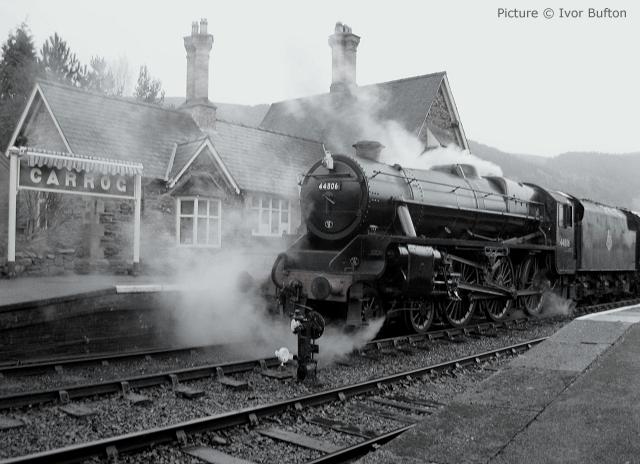
Sunday 5 January, and 44806 waits at Carrog to haul its last mile (or so) of public services on the Llangollen Railway, it would continue from Carrog to Bonwm and then be left on the rear for the return to Llangollen (D5310 hauling the train). At Llangollen, the plan was to, it would take the coaches to River Siding and then on to the shed for disposal (Ivor Bufton).
On the Welsh Highland
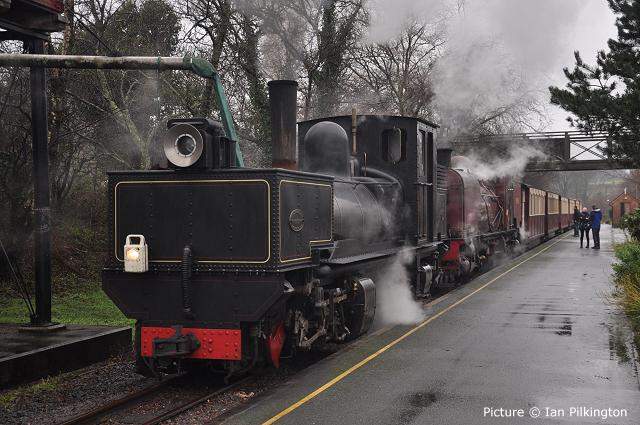
Garratts K1 and 138 stand at Waunfawr on the Welsh Highland Railway with the 10:00 Caernarfon-Porthmadog in heavy rain on Monday 30 December. Unfortunately the train had to be terminated here due to flooding, and shortly afterwards K1 ran round the train, which was then topped and tailed back to Caernarfon. The pioneer Garratt was being run in after overhaul. Picture by Ian Pilkington.
The Mostyn Story - by Alan Roberts
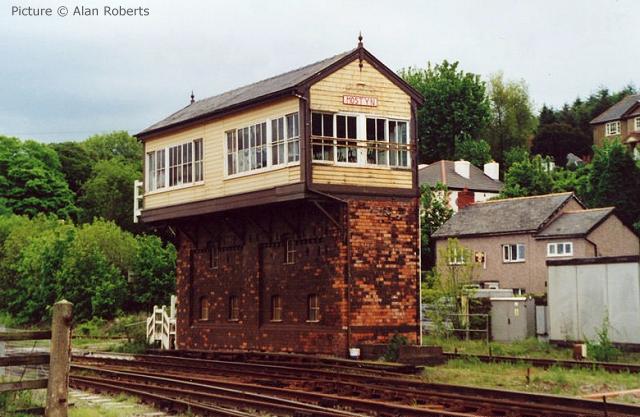
Following on from the item about Mostyn signalbox on the last issue, readers may be interested in the history of the signalling in the area. Mostyn originally had two signalboxes until 1943. Mostyn No.1 opened in July 1902, replacing an older box dating back to 1872, and is the current box renamed Mostyn in 1943 when Mostyn No.2 closed. The station fell under the Beeching axe and was closed on 14 February 1966; when it first opened on 1 May 1848 it claimed to be the first station lit by gas. The supply was changed later to electricity from the nearby Mostyn Iron Works Co.
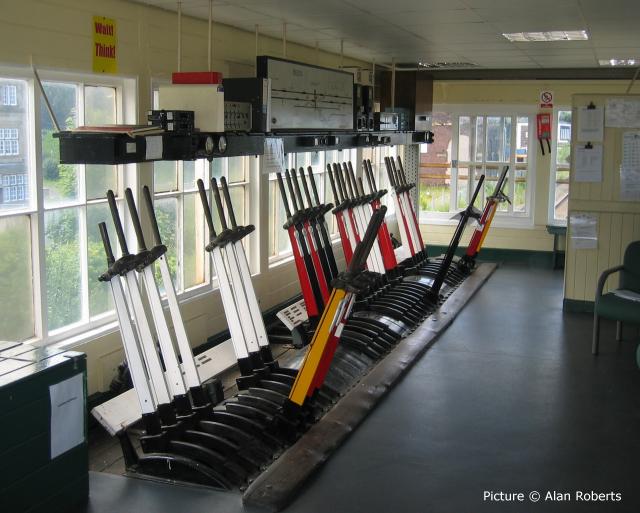
The present signalbox was built to a LNWR Type 4 design measuring 32’ 3½” x 12’ with a 15-foot elevation to the working floor and fitted with a LNW Tumbler frame of 40 levers. Due to the unusual design with a overhang on the up side the box received a listed status as from 10 March 1994.
Mostyn No.2 opened in August 1900 replacing a 7-lever ground frame controlling main line connections to the sidings at the Talacre side of the station. In 1943 No.2 signalbox closed and its control was taken over from Mostyn (ex-No1). The siding connections were thereafter controlled by two ground frames released from the signalbox. The siding connections to the main line lasted until April 1965 when they were abolished and replaced by plain line. The 1960s saw further reductions to track and signalling when the slow lines were taken out of use and lifted. The first section of slow lines to go were the ones between Mostyn and Holywell Junction; the down slow on 27 October 1966 and the up slow on 29 March 1967.
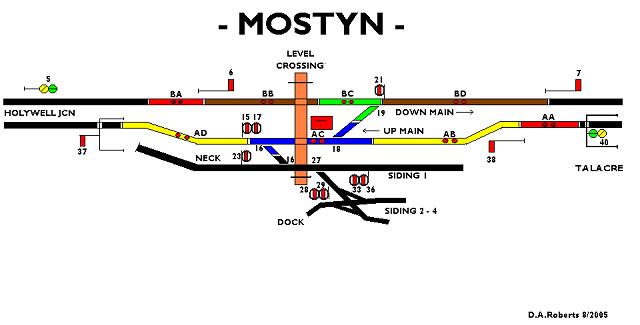
A section of the up slow past the signalbox was retained to give access to Eyton Siding (a mile towards Holywell Junction), the siding was shortened in the 1970s to form a shunting neck for the up sidings. From 19 March 1967 the down slow was abolished between Mostyn and Prestatyn followed by the up slow on 26 March 1967, again a section of the line was retained and renamed Siding 1, with the up sidings in the yard renumbered 2 to 5. Following the closure of Mostyn Ironworks in the late 1960s, the main function for Mostyn signalbox was to control access to the up sidings leading to the dock.
Rail traffic to and from Mostyn Dock has varied through the years including raw sulphur conveyed in hopper wagons for Amlwch, steel and at one point container traffic was trialled. Later traffic included tanks for the nearby Warwick International plant conveying Acetic Acid (white vinegar). When this traffic ceased in the late 1990s new incoming traffic conveying steel girders was started and was shipped over to Ireland. The steel traffic was only short-lived and finished altogether as from 10 November 2008. Nowadays the signalbox at Mostyn is only open as required for signal maintenance work or at certain times when engineering work takes place.
[Alan Roberts works as a signaller along the North Wales line.]
Club 55 is back (again)
The Arriva 'CLUB 55' (Off Peak travel offer for everyone aged 55 and over) is being made available again from 5 January to 29 March 2014. This version is attractive for travel within and out of North Wales to the whole Arriva network and with add-ons to other destinations.
For full details and conditions see : www.arrivatrainswales.co.uk/55 (A rather muddled website in our opinion).
The conditions state 'Travel using a Club 55 ticket is not permitted before 09:00 Monday to Friday except between the following locations: Shrewsbury – to or from Aberystwyth/Pwllheli; Shrewsbury – to or from Llanelli/Swansea via Llandrindod; Chester - Holyhead/Llandudno/Blaenau Ffestiniog; Neath - Milford Haven/Pembroke Dock/Fishguard Harbour; Wrexham Central - Bidston.' As we understand it, unlike in Autumn 2014 this means that North Wales Coast residents can make an early start to their trip. From the Manchester line and the Chester - Shrewsbury line one must wait until 09:30, although from Wrexham travel via Shotton before 09:30 is allowed.
The fare remains at £23 return (valid for eight days, nor a month as has been the case sometimes in the past) from and to any station served by Arriva Trains Wales station, or £28 if you want to travel on a Friday. A £1 discount applies to Senior and Disabled Railcard holders, and their are add-ons for extensions to other lines, including to London Marylebone via Chiltern Railways with their loco-hauled services for an extra £20.50.
175 cutouts
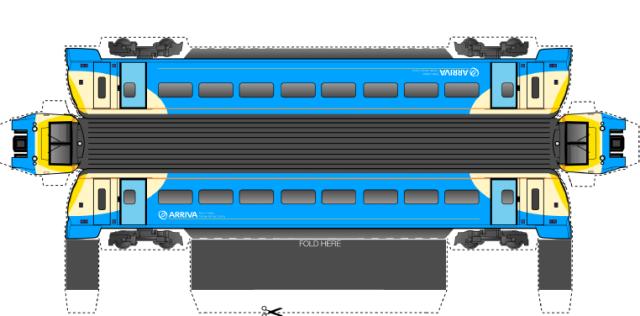
Two people responded to our Christmas challenge to re-livery in Arriva colours the cardboard model kit of a hypothetical single-unit Class 175 first issued years ago by First North Western. The links below are to the PDFs for download, both about 650 MB.
Incidentally, we referred in a previous outpouring to the 175 as an 'Adelante' which actually a name for the similar Class 180. The 175 is officially a 'Coradia'. Apologies.
Phil Alderson created the new Welsh Government livery.
Jack Bowley made the new livery and also the current 'original Arriva' version.
Well done and thanks to both of them - now, who's going to make the model (in any scale) and send a picture? With a little modification a 2 or 3-car version could be made, and how about glazing the windows...?
Llangollen News (2): New Year's Day - report by George Jones
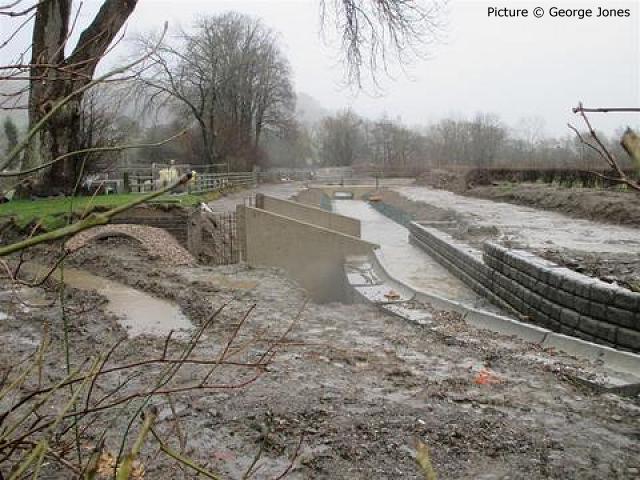
The weather on 1 January certainly matched the dismal forecast with heavy rain all morning and the option for the proposed walk was abandoned. In the circumstances, only the optimistic (!) turned up at Carrog but, thanks to Eddie Knorn, a road run was made to Corwen where the flood relief scheme site was viewed and we called in at Bonwm gates on the way back. Even in the soggy conditions the track extension looks impressive still.
The picture above shows the flood relief scheme channel as
seen looking from the rear of the Pavilion towards the station site
which runs across the middle of the view - the old bridge 30, now the
outfall pipe location, is to the right of the clump of trees - the need
for reinstatement of the trackbed level is perhaps obvious. Even
without the flood relief scheme being connected up to this channel
there was plenty of water about on this day!
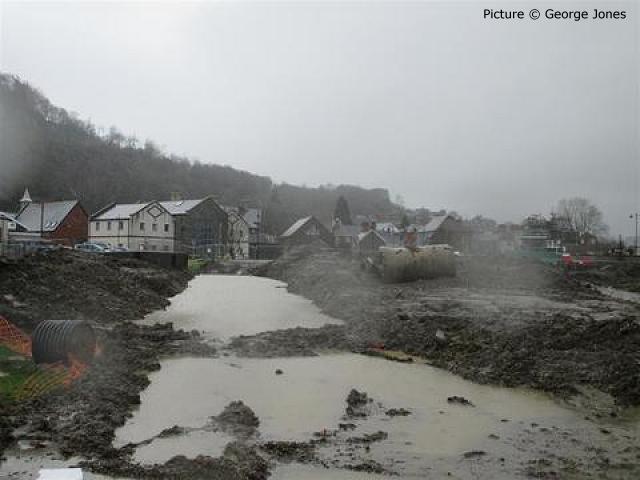

Looking towards the contractor's site, a new water
feature for Corwen has been created - this was the location of the
temporary road for the works access now taken up again but not
reinstated.
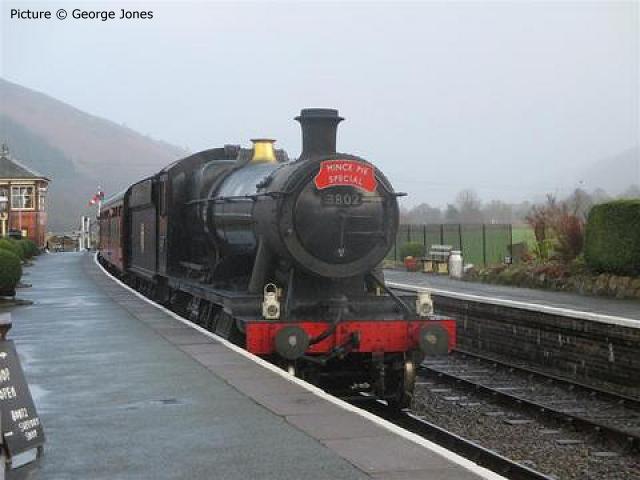

Around 13:00 the sun tried to come out and back at Carrog 3802
arrived on the second train of the New Year in improved lighting.
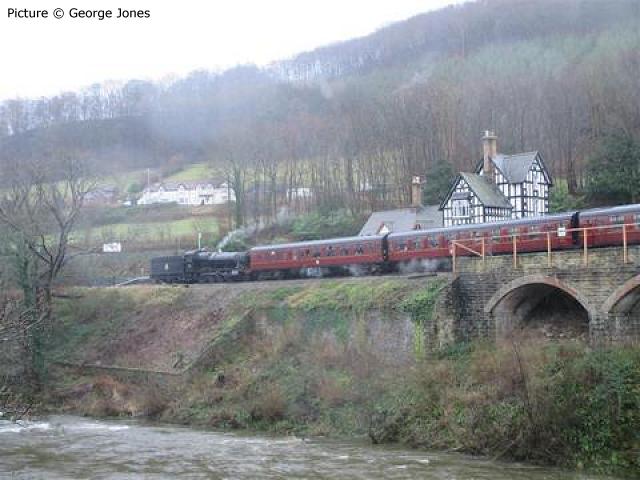

However, it was not to last; as seen passing Berwyn on the
return the conditions were grim with plenty of water in evidence.
Later 3802 ran round to prepare to take away the 15:00 Mince
Pie Special as the last train of the festive season. The wonder
is so many people turned out to travel on a day which did not encourage
visitors, but acknowledges the fact the Llangollen Railway is one of
the few attractions still operating at this time of the year.
As always thanks are due to all the staff who helped keep
the railway operating throughout the festive season. One can but hope
the income provided adequate net takings to keep the show on the rails
into the new year. For those disappointed not to have had the
chance to walk to Corwen, I will see if another opportunity will
present itself on the first day of the weekend running in February -
watch for a further announcement. Choosing a Saturday will at least
provide a bus service for the return leg.
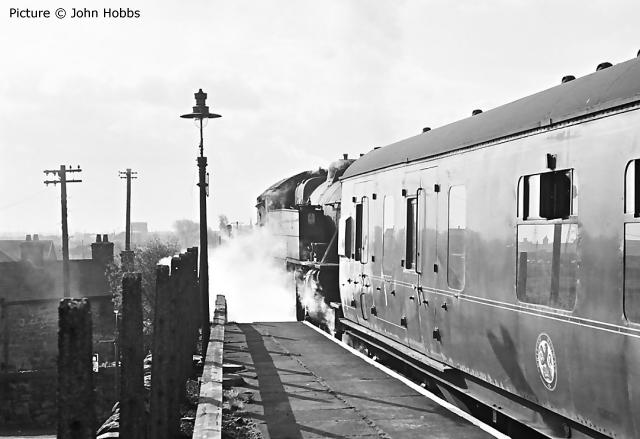
Fairburn Class 4 2-6-4T 42209 leaves Connahs Quay (above) one sunny morning with the 7.55am SX Rhyl to Chester on 4 May 1964. I used to travel to College, at Connahs Quay, on this train; it had different power nearly every day. I had foolishly elected to travel to College by road in September 1963; thus giving me more time in bed and was driven by a demented teenager in a mini van instead. The van eventually died and I had to go by train. If only I had stuck with the train for the whole College year...
Past Times with John Hobbs - Connahs Quay again

Fairburn Class 4 2-6-4T 42209 leaves Connahs Quay (above) one sunny morning with the 7.55am SX Rhyl to Chester on 4 May 1964. I used to travel to College, at Connahs Quay, on this train; it had different power nearly every day. I had foolishly elected to travel to College by road in September 1963; thus giving me more time in bed and was driven by a demented teenager in a mini van instead. The van eventually died and I had to go by train. If only I had stuck with the train for the whole College year...
Prior to my use of the 7.55am SX, it had been a duty for a
Rhyl (6K) Ivatt 2-6-2T ( or BR Std. Class 2 2-6-2T) and a
'Push & Pull' set. However when Rhyl shed closed and
with increasing numbers of students travelling it became a normal
train of corridor stock probably about six cars (although I cannot
remember the exact load). The introduction by Crosville of the 'Cymru
Coastliner' bus reduced numbers, as the bus stopped outside the college
where as rail users had to walk from Connahs Quay Station.
An example of the variety of locomotives used in the
week commencing 19th April 1964, follows; they were 42202 / 45184 /
45184 / 45429 / 45427, Crabs and BR Standard Class 4 4-6-0s also
appeared over the twelve-week period I used the service.
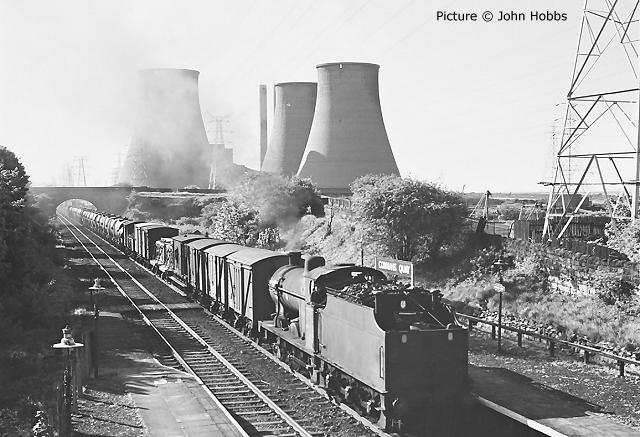

LMS Class 4F 0-6-0 44450 trundles through Connahs
Quay on 19 May 1964, with the evening trip from Holywell Junction
conveying acid tanks, the acid being used in the production of
Rayon. Other traffic at Holywell Junction was fireclay used
in the blast furnaces at Shotton which various contractors made into
special fire bricks; this was conveyed in small containers on 'Conflat
L' wagons. Ordinary vans make up the rest of the train.
Before Rhyl shed closed, 'Jinty' 47350 used to shunt all day
at Holywell Junction, returning light-engine between the Liverpool
and Manchester 'Club' trains and running fast line going like the
'Clappers', the big ends of the crank axle could be seen rotating at
high speed as the locomotive descended on Prestatyn.
I do not know what time it went out to Holywell Junction in
the morning but I never saw this move, even when I was delivering
papers at 7am. The locomotive was used, while at Holywell
Junction, to run along a line at the side of the river
between Llanerchymor, where the Duke of Lancaster is rotting
away today, and the present head shunt at the Rhyl end of the station;
this can be seen as a low embankment running across the fields towards
the river; ash from Rhyl shed was dumped along there as well as rock
when required by sea (river) defence work. The tide in the Dee estuary
is severe and many local children were drowned along this stretch of
embankment.
[Editor's note: Connah's Quay station closed in 1966, but I have an odd but vivid memory of passing through it, possibly in 1956, and noticing the LMS 'bulls-eye' style platform nameboard which for some reason had not been replaced by the BR standard enamelled one. The picture labelled '1950s' on the excellent Disused Stations website shows the BR version in place.]
[Editor's note: Connah's Quay station closed in 1966, but I have an odd but vivid memory of passing through it, possibly in 1956, and noticing the LMS 'bulls-eye' style platform nameboard which for some reason had not been replaced by the BR standard enamelled one. The picture labelled '1950s' on the excellent Disused Stations website shows the BR version in place.]
Excursion 1954 style
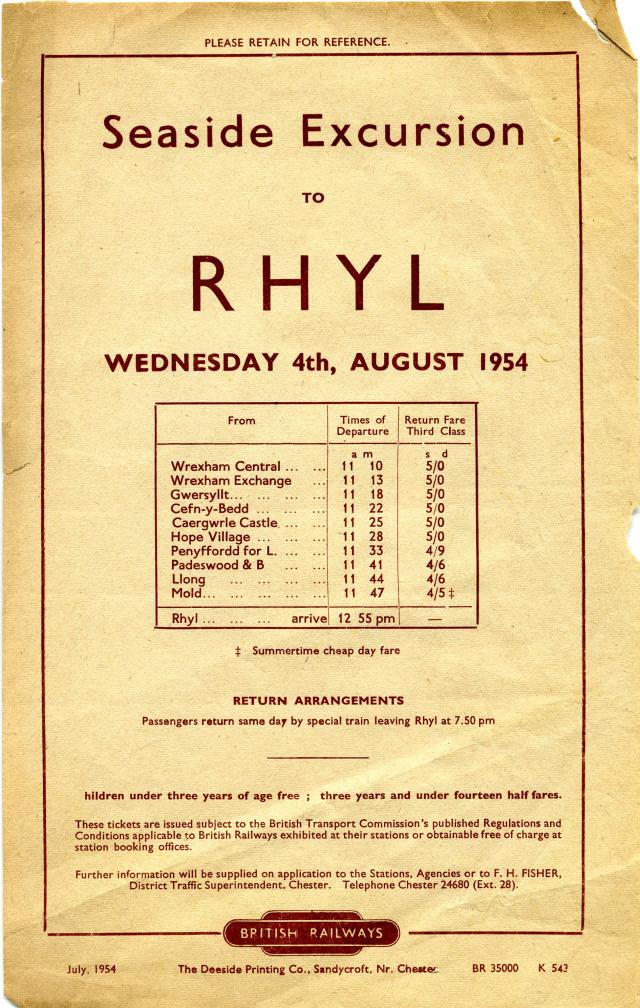
An excursion handbill from the early days of British Railways, courtesy of Dave Sallery. This special train ran along the Wrexham to Bidston line as far as Penyffordd. From there it ran via the long closed route via Mold, Denbigh and St. Asaph to Rhyl. A reversal would have been required at Denbigh. Nowadays an hourly service operates via Chester in under an hour, the return fare has increased from 5 shillings (25p) to £17.90 however!
The style of the bill, printed by a local firm, is interesting, in that its typography has something in common with the Johnston type used by London Transport (such as the diamond-shaped dot over the 'i') than the similar Gill Sans which was supposedly the BR standard.
North Wales Coast home page | Archive | Previous Notice Board